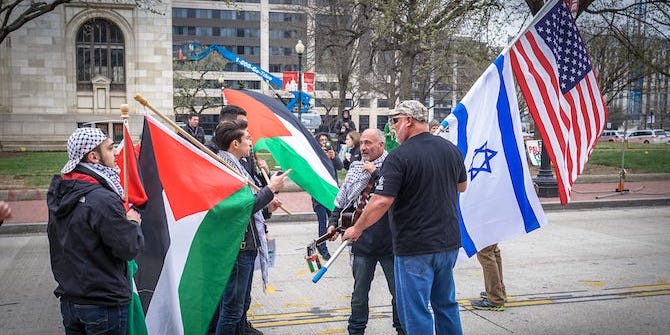by Rasha Kaloti

In December 2019, COVID-19 started its spread in Wuhan, China. By 11 March 2020, it was declared a pandemic by the WHO Director General, and had spread to 114 countries. Today, there are over three million confirmed cases globally and counting.
A common opinion among public health specialists, politicians and commentators suggests that this pandemic has made people equal by infecting individuals regardless of their financial status, position of power or geographical location. But does coronavirus really affect everyone equally?
A quick look at the facts will tell you that this pandemic is discriminatory. It exacerbates differences, vulnerability, and inequality – particularly in places like Palestine. Here are some of the reasons why.
Susceptibility to Infection
Susceptibility to infection is unequal among people; the ability to practice basic preventative measures varies greatly depending on one’s location. How can Palestinians living in overpopulated areas practice social distancing?
There are approximately 2 million Palestinians living in the Gaza-Strip, an open-air prison with 96 percent undrinkable water, that has been under Israeli siege for thirteen years and described by the United Nations in 2012 as ‘unliveable by 2020‘.
Meanwhile, the 19 refugee camps in the West Bank and East Jerusalem are overcrowded with more than 240,000 Palestinians. Israel’s military control and the intentionally debilitating building and property restrictions result in overcrowding in Palestinian areas. In Jerusalem’s Old City, Palestinian families of multiple generations live in residences intended for single-family use, and in East Jerusalem building permits are severely restricted.
There are approximately 300,000 Palestinians including Bedouin communities living in what Israel dubs ‘Area C’. This area constitutes 60 percent of the West Bank and is where Israel retains complete military and civil control, restricting any form of construction and development by Palestinians. Over the past three years, Israel has rejected 98 percent of Palestinian building permit requests in ‘Area C’.
This prevents Palestinians from accessing water facilities, which are discriminatorily expropriated by Israeli settlements illegal under international law, thus making it impossible for Palestinians to practice the most basic preventative hygiene measures.
Inequality of Treatment
Israel’s occupation has also damaged the Palestinian health system, which may not be able to cope with the spread of COVID-19.
Israel’s continuous attacks on the Gaza Strip have resulted in the destruction of medical facilities and hospitals, in addition to the killing and injuring of civilians.
Since the Great March of Return protests in March 2018, there have been approximately 37,000 injuries reported in Gaza. This hugely burdens the few hospitals in the city and it will be difficult to admit more COVID-19 cases if such assaults persist. The intentional and continuous electricity cuts by Israel will further impair hospitals’ abilities to respond to this pandemic.
The health system in the West Bank and Gaza is overstretched and suffers from shortages in medical staff, medications, medical equipment, testing kits and disinfectants. Such shortages would weaken any health system’s ability to effectively combat coronavirus. In Gaza, it will be difficult to replenish these needs due to Israel’s blanket and arbitrary border closures.
Confronting Challenges
While there is a high risk of coronavirus spreading rapidly in Palestine and leading to a catastrophe, thus far a wide spread of coronavirus has been prevented.
As of 1 May 2020, there are 507 confirmed cases and two deaths from COVID-19 in the West Bank and the Gaza-Strip, in addition to 163 cases in East Jerusalem. This number is much lower than in Israel (15,782 confirmed cases and 212 deaths), as well as compared to many other countries in the Middle East and worldwide.
The Palestinian Authority’s quick response and decisive actions have contributed to the slow spread of the outbreak. Strict lockdown measures in Bethlehem followed by the rest of the West Bank were implemented early on.
Palestinian communities have been proactive in combating this pandemic by adhering to quarantine and lockdown measures, and taking the necessary precautions to prevent COVID-19 from spreading further. Additionally, Palestinians have been supporting each other by distributing food and money to those in need, and some factories in the West Bank and the Gaza-Strip have started manufacturing face masks.
Palestinians know that a large-scale outbreak would be a nightmare within a nightmare, which is why their response has been positive and effective. The history of occupation and the hardships that come with it have taught Palestinians how to make tough decisions, react quickly and demonstrate solidarity with one another to overcome difficulties. For once, they feel a sense of ownership of their fate and are resisting Israel’s occupation by resisting this disease.
What we learn from COVID-19 is that it is exposing the power dynamics, inequalities and discriminatory measures by the occupier and the plight of the occupied. At the same time, the source of structural and deep-rooted discrimination has also contributed to instilling in Palestinians a sense of resoluteness in combating COVID-19, drawing on their community strength, unity and resistance.
This piece was originally published by Huck Magazine, and is reprinted here with their permission.







2 Comments